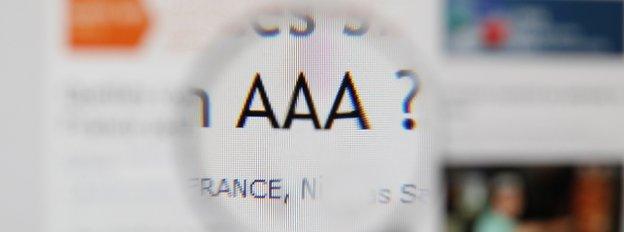The sound and the fury in US debates
- Published
- comments

As I'm writing this, the headlines are wavering between optimism and pessimism over a deal on the US debt ceiling with Thursday's purported deadline looming.
The alternative is hard to contemplate and the hope is that the US will pull back from the brink once again.
But, even if the US comes to another last minute agreement, damage has been inflicted as Fitch has downgraded the US outlook to negative which could lead the world's largest economy to lose its AAA rating once again.
Fitch assigned the negative outlook over the "repeated brinksmanship" over the debt ceiling, which opens the door to the US losing its top credit rating from two of the three major ratings companies.
Even if they agree to resolve it, Fitch says that "subsequent review of the ratings would take into account the manner and duration of the agreement and the perceived risk of a similar episode occurring in the future".
Almost the same scenario happened in 2011 when S&P downgraded the US in a historic moment. The agreement struck then raised the debt ceiling for two years to get through the presidential election. But, here we are again.
Looking back, the impact of the US losing its AAA rating was rather muted. In August 2011, the benchmark cost of borrowing for the US was roughly what it is now. The yield or interest rate paid on 10 year government bonds was 2.6%. Now, it's about 2.7%.
And US Treasuries remain the benchmark for debt of the highest quality.
Growing uncertainty
Still, there's more nervousness this time as it's happened again.
We saw this briefly in 2011, but the rise in short-term borrowing costs is much more pronounced this time. There's an "inversion" of the very short end of the US bond yield curve.
Normally, it costs more for a government to borrow over the longer-term because the chances of it not being repaid in the future are higher. A normal yield curve sees lower cost of borrowing for one month, three months, one year than for 10 and 30 years.
When a yield curve inverts, it means that short-term borrowing costs rise and are higher than longer-term ones.
There are two interpretations for an inverted yield curve. One is recession as investors expect interest rates to be cut in order to support the economy.
The second is default. Normally when a government defaults, short-term creditors lose out because they are often the ones that are not paid or are subject to debt restructuring and receive less than what they lent.
Since the debt ceiling wrangling, the US Treasury yield curve has inverted at the very short end. It now costs twice as much to borrow for one month than three months. The one month yield has jumped to 0.32% from 0.01% a month ago.
You would be right in thinking that the debt ceiling was officially hit in May so it's been going on for longer than that. That is indeed true, but it took the US Treasury Secretary Jack Lew saying on 25 September that the money will run out to pay bills on 17 October for it to fully register.
Minimal impact?
This is still a fairly small phenomenon and likely only of significance to banks and the markets at this stage.
But, it points to concerns over the US not getting its act together and what investors do could eventually affect us and our borrowing costs, which I have written about before.
As for the US potentially losing the top credit rating from two of the three ratings agencies, there would normally be concern that a country or a company that has a majority of non-AAA ratings could lose out because investors that have remits to invest only in AAA-rated debt would pull out.
Looking at Britain though, there hasn't been much of an effect. When the UK lost its AAA rating from Moody's, the loss was also historic. But, the second downgrade by Fitch didn't have a massive impact.
It's probably because rating companies' reputations have taken a beating since the financial crisis. I hear from investors that they feel fairly well-positioned to assess a country's economic potential and have begun to rely less on those agencies after the crash.
Also, the US, and to a lesser extent the UK, have central banks which have been buying government debt as part of their QE or quantitative easing programmes.
It's also likely due to the shrinking pool of AAA-rated countries to invest in. Recall that before the financial crisis, Spain and Ireland (both now receiving aid from the euro zone) were rated AAA.
At present, there are fewer than a dozen nations which are AAA rated across the board: Australia, Canada, Denmark, Finland, Germany, Luxembourg, Netherlands, Norway, Singapore, Sweden, and Switzerland. Some of those have negative outlooks attached as well, which means that the list could shrink even more within the next 2 years.
It normally takes more than a decade to restore a top AAA rating. And, it may not matter as much anymore.
But, the repeated brinksmanship over the debt ceiling is self-inflicted, and it brings to mind some aspects of American author William Faulkner's tale of financial ruin. The point about self-inflicted economic wounds, though, is that the US can do something about it.